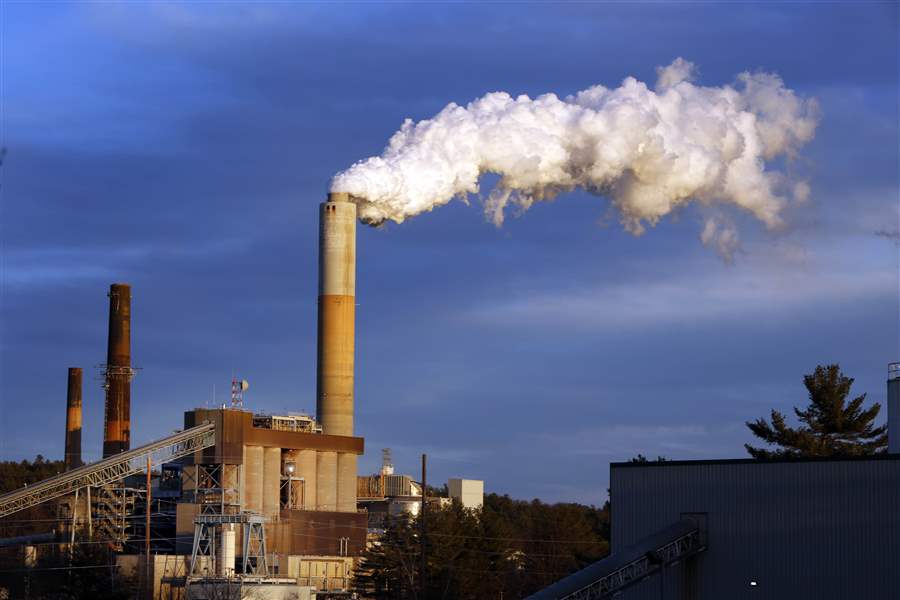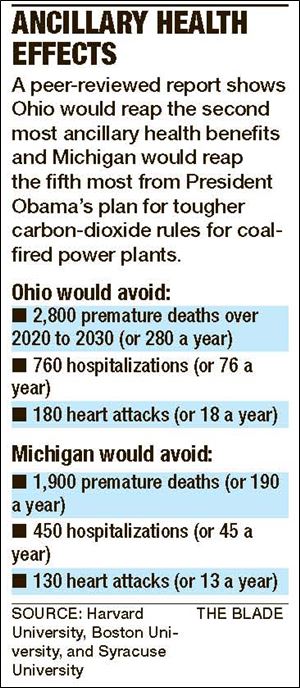
Ohio, Mich. could reap benefits of EPA rules
5/5/2015
ASSOCIATED PRESS

Ohio ranks second and Michigan ranks fifth in states that could reap ancillary health benefits if the U.S. Environmental Protection Agency follows through with strong rules this summer for climate-altering carbon dioxide gases emitted from coal-fired power plants, according to a peer-reviewed study issued Monday.
The report, published in the journal Nature Climate Change, was done by researchers at Harvard, Boston, and Syracuse universities, and the Washington-based Resources for the Future.
Through scientific modeling that accounts largely for population and proximity to coal-fired power plants, the study claims Ohio could avoid 2,800 premature deaths between 2020 and 2030 — an average of 280 a year — along with 760 hospitalizations and 180 heart attacks over that decade (76 and 18 a year, respectively).
Michigan could avoid 1,900 premature deaths between 2020 and 2030 — an average of 190 a year — along with 450 hospitalizations and 130 heart attacks over that decade (45 and 13, respectively).
Five of the 10 states most likely to benefit are in the Great Lakes region. Pennsylvania is first; Illinois is fourth, and New York is sixth.
Eric Zgodzinski, Toledo-Lucas County Health Department community and environmental health services director, said he wasn’t familiar with the report but agreed there’s a strong correlation between public health and air pollution in general.
“Any time we can reduce air pollution, whether it’s indoor or outdoor, it’s a benefit for our community,” Mr. Zgodzinski said.
He said improvements that are feasible should be considered.
Ken Fletcher, a Lansing-based advocacy specialist for American Lung Association offices that serve Ohio, Michigan, and other states in the Midwest, said a warming climate leads to more smog-forming ozone and particulate matter, which can affect everyone but especially people who suffer from asthma, chronic obstructive pulmonary disease, heart conditions, and diabetes.
“Cleaning up the carbon from those existing plants will have a great impact on climate change but also health,” Mr. Fletcher said.
Carbon dioxide is the most prevalent greenhouse gas linked to climate change, and coal-fired power plants are the largest sources for it.
The report’s co-author, Jonathan Buonocore, Harvard research fellow, told The Blade that co-pollutants such as sulfur dioxide, nitrogen oxide, and particulate matter — precursors to smog and soot — typically come down when carbon dioxide is reduced.

“The idea is that when you do something to regulate carbon, you also do something for the co-pollutants,” Mr. Buonocore said. “When we think of climate change, we often think of impacts happening far away.”
The Ohio Department of Health referred requests for interviews to the state Environmental Protection Agency.
Heidi Griesmer, Ohio EPA spokesman, referred The Blade to a 170-page filing the state agency previously made in opposition the Obama Administration’s proposal to tighten rules for coal-fired power plants under the Clean Power Plan.
The U.S. EPA is expected to finalize rules this summer.
The Ohio EPA said in its comments that its federal counterpart had “wildly extrapolated” data on health claims, that it had made “wildly speculative assertions of wide-ranging conclusions,” and had “overstepped logical regulatory authority.”
“Our own toxicological research was not able to establish any direct health effects from the regulation of [greenhouse gases],” the Ohio EPA said in its comments.
Ohio is one of America’s most heavily reliant states for coal-generated power.
Contact Tom Henry at: thenry@theblade.com, 419-724-6079, or via Twitter @ecowriterohio.